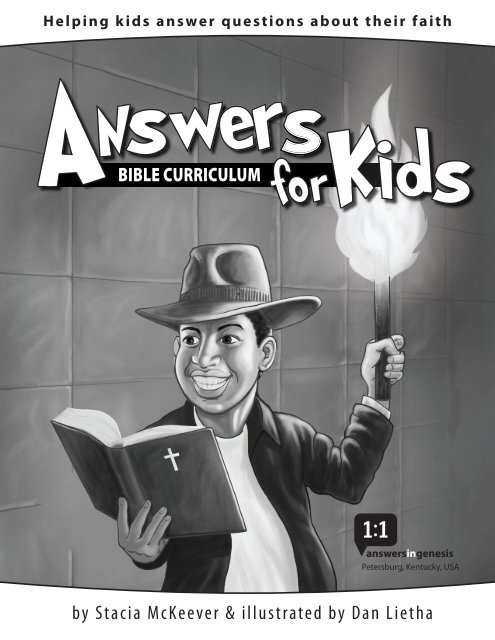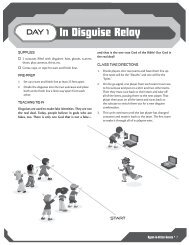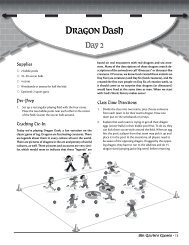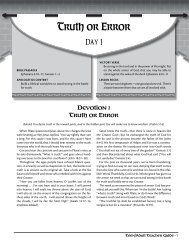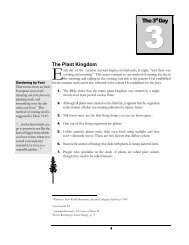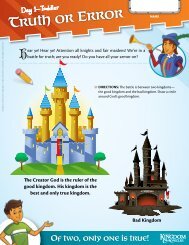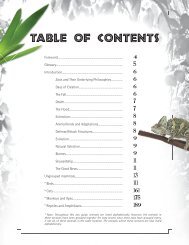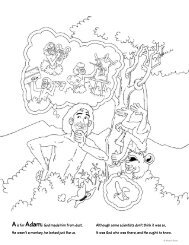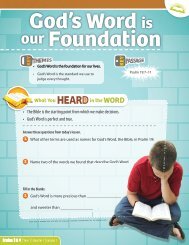BIBLE CURRICULUM - Answers in Genesis
BIBLE CURRICULUM - Answers in Genesis
BIBLE CURRICULUM - Answers in Genesis
- No tags were found...
You also want an ePaper? Increase the reach of your titles
YUMPU automatically turns print PDFs into web optimized ePapers that Google loves.
Copyright © 2010 <strong>Answers</strong> <strong>in</strong> <strong>Genesis</strong>. All rights reserved. No part of this book may be used orreproduced <strong>in</strong> any manner whatsoever without written permission from the publisher.For more <strong>in</strong>formation write: <strong>Answers</strong> <strong>in</strong> <strong>Genesis</strong>, PO Box 510, Hebron, KY 41048.Beg<strong>in</strong>n<strong>in</strong>gs Copyright © 2005 <strong>Answers</strong> <strong>in</strong> <strong>Genesis</strong>. All rights reserved.The Seven C’s of History Copyright © 2003 <strong>Answers</strong> <strong>in</strong> <strong>Genesis</strong>. All rights reserved.Questions Copyright © 2007 <strong>Answers</strong> <strong>in</strong> <strong>Genesis</strong>. All rights reserved.ISBN: 978-1-60092309-8Cover design: Dan Lietha & Diane K<strong>in</strong>gText layout: Diane K<strong>in</strong>gCD content: Daniel LewisEditors: Lori Jaworski, Becky Stelzer, Gary VaterlausScientific content editors: Bodie Hodge, Dr. Jason Lisle, Dr. David Menton, Dr. Terry Mortenson, Dr.Georgia Purdom, Michael Oard, Roger PattersonPr<strong>in</strong>ted <strong>in</strong> Ch<strong>in</strong>a
ContentsAbout the Authors ..........................................................................vIntroduction .................................................................................. viiLessons ........................................................................................... 111. Creation part 1............................................................................................132. Creation part 2............................................................................................213. Corruption part 1.......................................................................................274. Corruption part 2.......................................................................................335. Catastrophe part 1.....................................................................................396. Catastrophe part 2.....................................................................................477. Confusion part 1.........................................................................................558. Confusion part 2.........................................................................................619. Christ .............................................................................................................6710. Cross...............................................................................................................7711. Consummation ...........................................................................................8512. Is There Really a God? ................................................................................9113. How Did We Get the Bible? part 1.........................................................99- iii
14. How Did We Get the Bible? part 2...................................................... 10515. How Old Is the Earth? ............................................................................. 11116. Did God Create <strong>in</strong> 6 Days? .................................................................... 11717. How About a Date? part 1 .................................................................... 12518. How About a Date? part 2 .................................................................... 13119. What Is Compromise? ........................................................................... 13920. Where Did Humans Come From? part 1........................................... 14521. Where Did Humans Come From? part 2........................................... 15122. Have Animals Evolved? part 1.............................................................. 15723. Have Animals Evolved? part 2.............................................................. 16324. What About D<strong>in</strong>osaurs? part 1............................................................ 17125. What About D<strong>in</strong>osaurs? part 2............................................................ 17926. Why Are Snakes So Scary? ..................................................................... 18727. Why Do We Look Different? part 1..................................................... 19528. Why Do We Look Different? part 2..................................................... 20129. Was There an Ice Age? ............................................................................ 20930. What About Aliens? ................................................................................ 217Student Handouts ...................................................................... 225Student Charts ............................................................................ 285iv -
About the AuthorsStacia McKeever graduated from Clearwater Christian College and worked full-timefor <strong>Answers</strong> <strong>in</strong> <strong>Genesis</strong>–USA for more than ten years. She coauthored the “<strong>Answers</strong>for Kids” section <strong>in</strong> Creation magaz<strong>in</strong>e for several years and has written articles for<strong>Answers</strong> magaz<strong>in</strong>e, Teach Kids!, and the AiG website. She is currently the projectmanager for AiG’s VBS programs and lives with her husband and children <strong>in</strong> theGreater C<strong>in</strong>c<strong>in</strong>nati Area.Dan Lietha has been draw<strong>in</strong>g s<strong>in</strong>ce he was a child. He graduated <strong>in</strong> 1987 from theJoe Kubert School of Cartoon and Graphic Art and has been a full-time professionalcartoonist s<strong>in</strong>ce 1991. S<strong>in</strong>ce jo<strong>in</strong><strong>in</strong>g the <strong>Answers</strong> <strong>in</strong> <strong>Genesis</strong> staff <strong>in</strong> 1997, he hasillustrated several books (<strong>in</strong>clud<strong>in</strong>g A is for Adam, When Dragons’ Hearts Were Good,and The Great D<strong>in</strong>osaur Mystery Solved!), created comic strips for the AiG newsletterand website, and produced countless illustrations which the AiG speakers use toeffectively communicate the message that God’s Word can be trusted from thebeg<strong>in</strong>n<strong>in</strong>g. Dan, his wife Marcia, and their daughter Hannah currently reside <strong>in</strong> theGreater C<strong>in</strong>c<strong>in</strong>nati Area.About the Authors - v
vi - About the Authors
IntroductionThe <strong>Answers</strong> For Kids curriculum is a 30-lesson apologetics program for upperelementary students. It may be used as a Sunday school curriculum, a Christian schoolor homeschool course, or for family devotions. Our goal is to help children developa truly biblical worldview, and provide answers to the questions that children haveabout the Bible, history, and science.Seven C’s of HistoryThe <strong>Answers</strong> For Kids curriculum beg<strong>in</strong>s by teach<strong>in</strong>g children about the Seven C’s ofHistory—seven foundational events from the beg<strong>in</strong>n<strong>in</strong>g to the end of time. We helpchildren develop a biblical worldview and see how these events have affected (or willaffect) the world <strong>in</strong> which we live.We recommend post<strong>in</strong>g the Seven C’s of History Timel<strong>in</strong>e <strong>in</strong> your classroom so thatyou can refer to it while teach<strong>in</strong>g. This will re<strong>in</strong>force the Seven C’s, and show studentsthat the events and topics they are learn<strong>in</strong>g about connect with real history, and arenot just “Bible stories.”Follow<strong>in</strong>g these first eleven foundational lessons, students will beg<strong>in</strong> to explorequestions about the Bible, the earth, creation, evolution, d<strong>in</strong>osaurs, etc. We want tohelp young students see how the Bible relates to all of life, and how biblical history(as taught <strong>in</strong> the Seven C’s) helps expla<strong>in</strong> the world <strong>in</strong> which we live today.Introduction - vii
Lesson Components1. Lesson Time: We trust these lessons will help you to teach children to upholdthe Bible’s authority and to answer the questions that are hurled at them bytoday’s <strong>in</strong>creas<strong>in</strong>gly evolutionized culture. In various places throughout thelessons, we suggest hav<strong>in</strong>g children read a verse or paragraph out loud. Pleasefeel free to modify this idea accord<strong>in</strong>g to the abilities of your students or yourconstra<strong>in</strong>ts as a teacher. Illustrations are marked as such. Bolded sentencesare to be read to students. Non-bolded sentences are notes to the teacher.2. Activity Ideas: This section provides suggested ideas for activities for you to<strong>in</strong>corporate <strong>in</strong>to the lessons, as you have time.3. Extension Activities: For those <strong>in</strong>terested <strong>in</strong> us<strong>in</strong>g <strong>Answers</strong> for Kids as a spr<strong>in</strong>gboardto discuss<strong>in</strong>g other topics, or as part of a homeschool unit study, we have providedadditional study ideas.4. Recommended Resources: This section provides a list of materials that supplementthe topic be<strong>in</strong>g discussed.5. Internet L<strong>in</strong>ks: Onl<strong>in</strong>e articles are mentioned throughout the lessons so thatyou can f<strong>in</strong>d more <strong>in</strong>formation on the topics discussed. All of these articles areorganized by lesson and posted at the onl<strong>in</strong>e Teacher’s Resource Page: www.<strong>Answers</strong>In<strong>Genesis</strong>.org/go/<strong>Answers</strong>ForKids.6 CD-ROMs: The <strong>Answers</strong> for Kids Song CD conta<strong>in</strong>s all of the songs that are used<strong>in</strong> the lessons. The Teacher Resource CD-ROM conta<strong>in</strong>s the illustrations andhandouts that will be used throughout this curriculum. You may wish to use theillustrations <strong>in</strong> a digital presentation (such as PowerPo<strong>in</strong>t), or simply pr<strong>in</strong>t themout on transparencies or on pla<strong>in</strong> paper.7. Student Handouts: You will need one set of student handouts per child <strong>in</strong>your class (there is one student handout per lesson, and several wall charts—these are not <strong>in</strong>cluded on the CD-ROM). We have <strong>in</strong>cluded one complete set<strong>in</strong> the back of this Teacher’s Manual—additional sets are available from www.<strong>Answers</strong>Bookstore.com.viii - Introduction
Verse Review IdeasEach lesson conta<strong>in</strong>s a suggested memory verse for each week. We have listed just afew of the many ways to help the students learn the Scripture passages.Erase a word and repeat it aga<strong>in</strong>. Cont<strong>in</strong>ue to do this until you’ve erased theentire verse.familiar song.order (if you have a large class, you may want to make several sets of the verse).follow along and help the volunteer when he needs it.Scripture Read<strong>in</strong>g IdeasThis curriculum is based heavily around read<strong>in</strong>g passages from the Bible. There areseveral ways you might do this (depend<strong>in</strong>g on your constra<strong>in</strong>ts as a teacher, the classtime you have, etc.):<strong>in</strong> turn.We trust this curriculum will be a bless<strong>in</strong>g and encouragement to you and those <strong>in</strong>your class. If you have any questions or comments, please email us at education@answers<strong>in</strong>genesis.org.Introduction - ix
Evaluation FormAt <strong>Answers</strong> <strong>in</strong> <strong>Genesis</strong> we are committed to produc<strong>in</strong>g high-quality resourcesthat help believers proclaim and defend their faith. But we rely on your <strong>in</strong>putfor cont<strong>in</strong>ued success. Please take a few m<strong>in</strong>utes to give us your feedback on the<strong>Answers</strong> for Kids curriculum. There is an evaluation form on the CD-ROM. Pleasepr<strong>in</strong>t this out, fill it out as completely as possible, and send it back to us. As a thankyou for return<strong>in</strong>g this evaluation, you will receive 10% off of a future purchase atour onl<strong>in</strong>e bookstore (see bottom of evaluation form for details).x - Introduction
H e l p i n g k i d s a n s w e r q u e s t i o n s a b o u t t h e i r f a i t hA nswers<strong>BIBLE</strong> <strong>CURRICULUM</strong>forKidsTeacher Manualb y S t a c i a M c K e e v e r & i l l u s t r a t e d b y D a n L i e t h a
A nswers<strong>BIBLE</strong> <strong>CURRICULUM</strong>forKidsLesson 1Creation part 1IN SIX DAYS . . . C. 4004 BCScriptureLesson Truths<strong>Genesis</strong> 1:1–2:3Memory verse<strong>Genesis</strong> 1:1God is the Creator of everyth<strong>in</strong>gGod is good; everyth<strong>in</strong>g He made was “very good”God created <strong>in</strong> six normal-length days, about6,000 years agoVisuals & MaterialsPreparationFlashlight, small ball;from CDs: Illustrations1-00–1-10, L1a, L1b, L1c,Memory Verse graphic, TheSeven C’s of History (song)1.2.3.4.Read “Could God Really Have Created Everyth<strong>in</strong>g<strong>in</strong> Six Days?” at the onl<strong>in</strong>e Teacher’s Resource Page(www.<strong>Answers</strong>In<strong>Genesis</strong>.org/go/<strong>Answers</strong>ForKids)Study the Scripture passage for this weekReview the lesson before class so that you arefamiliar with the contentPray that God will open the eyes and heartsof your students to glorify Him as Creator andunderstand the importance of tak<strong>in</strong>g His Word aswrittenCreation part 1 - 13
Lesson 1Lesson OverviewSome people believe the universe is billions of years old. It is often pictured as com<strong>in</strong>g fromthe result of a giant explosion—the big bang. These people believe that all liv<strong>in</strong>g th<strong>in</strong>gs (andwe ourselves!) came from a series of accidents (mutations) happen<strong>in</strong>g gradually over millionsof years. Others believe that God used evolution to “create” over millions of years. Still othersbelieve that God created progressively over millions of years.But these views do not agree with the biblical record. These are the views that we need to“tear down” <strong>in</strong> the m<strong>in</strong>ds of our children. In their place, we need to “build up” the truth thatthe Bible, God’s Word to us, records the true history of the universe. It gives a completelydifferent account of how everyth<strong>in</strong>g came to be and what has happened s<strong>in</strong>ce then. TheBible reveals that God didn’t use evolution to create and that the earth isn’t millions of yearsold. In this lesson, children will learn that God created all th<strong>in</strong>gs <strong>in</strong> six actual days and thatthe orig<strong>in</strong>al creation was “very good.”Lesson TimeWelcomeWelcome students to class, open <strong>in</strong> prayer, etc.How We Know about Events that Happened <strong>in</strong> the PastHow many of you know your birth date? Wait for answers. Of course you do—but how doyou know which day it is? Can you remember back that far? Wait for answers—parentstold me, etc. Of course, you can’t remember the event, but at least one of your parentswas there, and probably a doctor and nurses, and one of them recorded the date foryou. They were eyewitnesses to the event of your birth—they saw it happen, didn’tthey? So they know when you were born, and hopefully you can trust them to tell youthe truth about that day.What about other events that have happened <strong>in</strong> the past? For example, the Civil War.How do you know the Civil War actually happened? Wait for answers: learned about it atschool, watched a TV program/movie, read about it <strong>in</strong> history books, etc. Where did the<strong>in</strong>formation <strong>in</strong> those television shows or history books come from? Wait for answers.It ma<strong>in</strong>ly came from eyewitnesses to the events—either they wrote down what theyexperienced, or told other people what happened, and those people repeated it toothers who repeated it, and so on. Sometimes, however, the orig<strong>in</strong>al accounts have beenchanged over time, or the person who witnessed the event wanted to tell the story <strong>in</strong> aparticular way to make himself look better, or the witness saw only part of the event.14 - Creation part 1
A nswers<strong>BIBLE</strong> <strong>CURRICULUM</strong>forKidsWhat about events that have happened even farther back <strong>in</strong> history—events thathappened thousands of years ago? What we need is an eyewitness who always tells thetruth, who can never lie, and who has been around at least s<strong>in</strong>ce the beg<strong>in</strong>n<strong>in</strong>g. Can youth<strong>in</strong>k of anyone like that? God. Right—God has been orchestrat<strong>in</strong>g events s<strong>in</strong>ce beforethe beg<strong>in</strong>n<strong>in</strong>g. What do we call the collection of 66 books <strong>in</strong> which He has recorded whatHe wants us to know? The Bible. Right—the Bible. S<strong>in</strong>ce God never lies, we can trust theBible to tell us the truth concern<strong>in</strong>g the events God tells us about.Illustration 1-01. In fact, we could call the Bible “The History Book of the Universe.”The Seven C's of History and the First C: CreationOver the next few months, we’re go<strong>in</strong>g to be learn<strong>in</strong>g about seven major events thatthe Bible tells us about that have affected—and one that will affect—the history of theworldIllustration 1-02. These events are Creation, Corruption, Catastrophe, Confusion,Christ, Cross, and Consummation. Have students review the words with you a few times.You may not understand what each word means right now, but we’ll learn about themas we go along. Today we’re go<strong>in</strong>g to beg<strong>in</strong> with the first C, Creation.Pass out the student handouts for this week, and have students turn to the back side ofthe page, The First Six Days Are History! Read through this page with the students as an<strong>in</strong>troduction to this topic.Like we read <strong>in</strong> the cartoon, some people say we’re not to believe that the first couplechapters of <strong>Genesis</strong> record actual history. However, God knows what He did, and wecan trust Him to tell us the truth. Today and next week, we’re go<strong>in</strong>g to learn a bit moreabout what the Bible says happened on the first six days of history.Day One of CreationHave students open their Bibles to <strong>Genesis</strong> 1. Read <strong>Genesis</strong> 1:1–5 together.Illustration 1-03. What did God create on the first day? Light, earth, day-and-nightcycle. God created light, and a day-and-night cycle, but does this set of verses mentionanyth<strong>in</strong>g about the sun? Wait for answer: no. Right—God created only light on this day—not the sun. He created the sun three days later. Today, the sun gives us light dur<strong>in</strong>g theday, and the moon gives light dur<strong>in</strong>g the night. So, <strong>in</strong> the beg<strong>in</strong>n<strong>in</strong>g, how could there beday and night without the sun? Let’s f<strong>in</strong>d out.Actually, we have figured out that all it takes to have a day and night is a rotat<strong>in</strong>g earththat is sp<strong>in</strong>n<strong>in</strong>g and light com<strong>in</strong>g from one direction. The Bible tells us clearly thatGod created light on the first day, as well as the earth. Use a flashlight and small ball toCreation part 1 - 15
Lesson 1illustrate. Turn the flashlight on, direct it at the ball, and then beg<strong>in</strong> rotat<strong>in</strong>g the ball—wherethe light hits the ball is “day” and where it doesn’t is “night.” We can figure out that theearth was already rotat<strong>in</strong>g <strong>in</strong> space on the first day and that light was sh<strong>in</strong><strong>in</strong>g on it—so<strong>in</strong> the beg<strong>in</strong>n<strong>in</strong>g, there was still day and night, even though there wasn’t any sun yet.There are some people who believe that the sun is the source of all life. However, does theBible teach this? Wait for answers. No; <strong>in</strong> fact, God seems to be mak<strong>in</strong>g a very big po<strong>in</strong>tthat He is the Creator of everyth<strong>in</strong>g—<strong>in</strong>clud<strong>in</strong>g the sun, which He didn’t create until later.God doesn’t “need” the sun <strong>in</strong> order to create life. In fact, He warns aga<strong>in</strong>st worshipp<strong>in</strong>git. Have the students turn to Deuteronomy 4:15–19 and choose a student to read it.Day Two of CreationOkay, let’s f<strong>in</strong>d out what God created on the second day. Have students turn back to<strong>Genesis</strong> 1:6–8, and choose a student to read the passage.Illustration 1-04. The first th<strong>in</strong>g He did on this day was to create an expanse thatseparated the waters above the earth from the waters that were on the earth. Thisis when He formed the atmosphere that would be needed to support the life that Hewould soon create. Can anyone tell me what the atmosphere is? Wait for answers. It’s thestuff that we breathe <strong>in</strong>. Everyone take a deep breath. Okay, now let it out. That “stuff”that we just breathed <strong>in</strong> is called the atmosphere. God knew we would need to breathe,so He created stuff for us to breathe on the second day. [See Note 1 on page 20.]Day Three of CreationLet’s move on to the third day. Read <strong>Genesis</strong> 1:9–13 together.Illustration 1-05. What happened dur<strong>in</strong>g the third day? Wait for answers. Right; dryland appeared with all the dirt that plants need to grow <strong>in</strong>, and God then created thevarious k<strong>in</strong>ds of plants. Why? Wait for answers. God knew that the animals and humansHe would create later <strong>in</strong> the week would need someth<strong>in</strong>g to eat, so He created plantsfor them to eat and enjoy. God was tak<strong>in</strong>g care of His creation, wasn’t He? He made theatmosphere so we could breathe, and plants so we could eat! [See Note 2 on page 20.]Day Four of CreationRead <strong>Genesis</strong> 1:14–19 together.Illustration 1-06. Why did God create the sun, moon, and stars on the fourth day? Waitfor answers. Aga<strong>in</strong>, He did it for us—the sun gives us light and warmth dur<strong>in</strong>g the day,and the moon gives us light dur<strong>in</strong>g the night. The stars mark off signs and seasons,although the seasons we have today are probably more extreme than they were <strong>in</strong> the16 - Creation part 1
A nswers<strong>BIBLE</strong> <strong>CURRICULUM</strong>forKidsbeg<strong>in</strong>n<strong>in</strong>g. In fact, God not only created the stars, but He also gave them names! Let’sturn to Isaiah 40:26. Choose a student to read this verse. The Bible also talks about God’spower over the stars <strong>in</strong> Job 38. Have students turn to Job 38:31–32. And it tells us that theheavens declare His glory. Read Psalm 19:1–4.Illustration 1-07. He also created the rest of the planets and other stellar bodies on thisday. [See Note 3 on page 20.]Day Five of CreationIllustration 1-08. Okay, let’s move on to the fifth day. Read <strong>Genesis</strong> 1:20–23 together.What k<strong>in</strong>ds of creatures live <strong>in</strong> the seas? Wait for answers: whales, octopi, starfish, seacucumbers, fish, coral, etc.Illustration 1-09. Use this illustration to encourage students to also list plesiosaurs. Whattype of creature is this? Many will know it’s a plesiosaur—be sure they understand that thistype of creature was created on the same day as all the other sea creatures (not millions ofyears ago) and lived along with fish, whales, etc. <strong>in</strong> the beg<strong>in</strong>n<strong>in</strong>g.What types of creatures fly <strong>in</strong> the air? Birds, bats, etc.Illustration 1-10. Use this illustration to encourage students to realize that this typeof creature was also created on this day, along with all other fly<strong>in</strong>g th<strong>in</strong>gs. What type ofcreature is this? Pteranodon.There are some people who believe that land animals eventually turned <strong>in</strong>to birds andwhales, but is that what the Bible teaches? Encourage students to see that land animalswere created after fly<strong>in</strong>g and sea creatures.What should we do when we hear this type of th<strong>in</strong>g—maybe from our teachers, ortextbooks, or TV, or a movie? Encourage the students to see that we can know that suchstories aren’t true, because the only eyewitness has told us that birds and whales were createda day before the land animals were created.Review and PrayerReview the memory verse for this week: <strong>Genesis</strong> 1:1. Pray with your students, prais<strong>in</strong>g God asCreator and thank<strong>in</strong>g Him for His amaz<strong>in</strong>g creation.Next week we are go<strong>in</strong>g to look at the sixth day of creation, what k<strong>in</strong>ds of animals werecreated, and how man was specially created.Creation part 1 - 17
Lesson 1Discussion Questions1. In this first series of lessons, we’re discuss<strong>in</strong>g the Seven C’s of History—seven major eventsthat have affected (or will affect) the world. How did the first C, Creation, affect the world?Answer: Creation was the beg<strong>in</strong>n<strong>in</strong>g of everyth<strong>in</strong>g!2. What is our month based on?Answer: The movement of the moon around the earth.3. What is our year based on?Answer: The movement of the earth around the sun.4. The way the earth is tilted <strong>in</strong> space determ<strong>in</strong>es our seasons, but what determ<strong>in</strong>es that a weekis seven days long?Answer: The account <strong>in</strong> <strong>Genesis</strong> (have them recite Exodus 20:11).5. When did plesiosaurs and pteranadons first appear on earth?Answer: On Day Five of creation, about 6,000 years ago—not millions of years before humans.(We are go<strong>in</strong>g to learn a lot more about d<strong>in</strong>osaurs <strong>in</strong> one of our later lessons.)Activity Ideas1. Start a “Days of Creation” booklet. Have the students draw pictures of the major events ofeach day. Use handout L1a. Or use L1b and have students color <strong>in</strong> the days.2. Start a timel<strong>in</strong>e on a large sheet of paper (e.g., the k<strong>in</strong>d used to cover tables). Mark off sixmillennia, perhaps to the scale of 1,000 years=1 foot or 1,000 years=2 feet (whatever youdecide based on the space available). Dur<strong>in</strong>g this lesson, label “Creation, 4004 BC” and“Today, AD 2000.” (See lesson 16 for help <strong>in</strong> determ<strong>in</strong><strong>in</strong>g the age of the earth.) Have studentschoose a creation day to illustrate, or makes copies of L1b, cut each day apart, and pass outthe different days to students (depend<strong>in</strong>g on your class size, there will be duplication ofdays). Have them color a day. Tape or glue the various days to the timel<strong>in</strong>e under “Creation.”We’ll be add<strong>in</strong>g to the timel<strong>in</strong>e each week dur<strong>in</strong>g the Seven C’s lessons.18 - Creation part 1
Extension ActivitiesA nswers<strong>BIBLE</strong> <strong>CURRICULUM</strong>forKidsThese are ideas you can use to supplement your discussion of the various days of creation.Physics (Day 1)Spend some time study<strong>in</strong>g the nature of light. See “What is Light?” on the onl<strong>in</strong>e Teacher’sResource Page for a simple explanation on the nature of light. Volume 2 (experiment 5) ofScience and the Bible provides a neat experiment on light.Use a concordance to f<strong>in</strong>d out what else the Bible has to say about light.F<strong>in</strong>d out more about gravity—the attractive force between all objects. Who is the Onewho truly holds all th<strong>in</strong>gs together? See “Gravity: The Mystery Force” at the onl<strong>in</strong>e Teacher’sResource Page. Volume 1 (experiment 22) of Science and the Bible offers a simple experimentthat illustrates the effects of gravity.Angels (Day 1)When did God create the angels? When did Satan fall? See “Demons on a Leash” at the onl<strong>in</strong>eTeacher’s Resource Page for some <strong>in</strong>sights.Chemistry (Day 2)Spend some time study<strong>in</strong>g the properties of water. See chapter 10 of Explor<strong>in</strong>g the World ofChemistry for help. Volumes 1 (experiment 30), 2 (experiment 26), and 3 (experiment 30) ofScience and the Bible offer great simple experiments that will help <strong>in</strong> discuss<strong>in</strong>g this topic.Botany (Day 3)Learn about some of the amaz<strong>in</strong>g design features found <strong>in</strong> the plant world from the “Get<strong>Answers</strong>: Botany” section of the <strong>Answers</strong> <strong>in</strong> <strong>Genesis</strong> Website (use the l<strong>in</strong>k on the onl<strong>in</strong>eTeacher’s Resource Page at www.<strong>Answers</strong>In<strong>Genesis</strong>.org/go/<strong>Answers</strong>ForKids). What isphotosynthesis? (See chapter 7 of Explor<strong>in</strong>g the World Around You.) Take a walk outsideand collect different plant specimens, then press and dry them. Once dry, glue them ontodifferent sheets of paper and write a brief description beneath or beside each plant. Start agarden (outside if you have the space, or <strong>in</strong>side <strong>in</strong> pots).Astronomy (Day 4)How do the heavens “declare the glory of God” (Psalm 19:1)? Visit the “Get <strong>Answers</strong>:Astronomy” section of the AiG website for some ideas. Put together a booklet with briefsummaries and pictures of your f<strong>in</strong>d<strong>in</strong>gs. What is wrong with the big bang idea? See“What Are Some of the Problems With the Big Bang Hypothesis?” at the onl<strong>in</strong>e Teacher’sResource Page.Creation part 1 - 19
Lesson 1Recommended ResourcesNotesThe <strong>Answers</strong> Book for Kids, volume 1 (book for children)Explor<strong>in</strong>g Planet Earth (textbook for children)Explor<strong>in</strong>g the World Around You (textbook for children)Explor<strong>in</strong>g the World of Chemistry (textbook for children)Science and the Bible, volumes 1–3Six Short Days! (DVD for children)Available from www.<strong>Answers</strong>Bookstore.com or by call<strong>in</strong>g 1-800-778-3390.1. If you are familiar with the “vapor canopy” model, please note that many creation scientistshave abandoned the vapor canopy model or no longer see any need for such a concept. Formore <strong>in</strong>formation, read “Noah’s Flood: Where Did the Water Come From?” at the onl<strong>in</strong>eTeacher’s Resource Page.2. The creation of plants on Day 3—before the sun and animals—is contrary to the beliefs ofevolutionists and other “long-agers” who teach that plants arose long after the sun came<strong>in</strong>to existence.Are plants “alive”? The Bible makes a clear dist<strong>in</strong>ction between the status of plants andanimals. Plants are not alive <strong>in</strong> the biblical sense. People and animals are described <strong>in</strong> <strong>Genesis</strong>as hav<strong>in</strong>g, or be<strong>in</strong>g, nephesh (Hebrew)—see <strong>Genesis</strong> 1:20–21, 24, where nephesh chayyah istranslated “liv<strong>in</strong>g creatures,” and <strong>Genesis</strong> 2:7, where Adam became a “liv<strong>in</strong>g soul” (nepheshchayyah). Nephesh conveys the basic idea of a “breath<strong>in</strong>g creature.” It is also used widely<strong>in</strong> the Old Testament, <strong>in</strong> comb<strong>in</strong>ation with other words, to convey emotions, feel<strong>in</strong>gs, etc.Perhaps nephesh refers to life with a certa<strong>in</strong> level of consciousness. Plants do not have suchnephesh, so Adam eat<strong>in</strong>g a carrot did not <strong>in</strong>volve “death” <strong>in</strong> the biblical sense.3. Some people ask, “If the universe is only a few thousand years old, then how can we seelight from stars that are over one billion light-years away?” There are several possibleanswers to this question, and creation scientists are actively research<strong>in</strong>g this topic. See “DoesDistant Starlight Prove the Universe Is Old?” at the onl<strong>in</strong>e Teacher’s Resource Page for more<strong>in</strong>formation.20 - Creation part 1
NAME<strong>BIBLE</strong> <strong>CURRICULUM</strong>CreationPart 1Lesson1“The Seven C’s of History” (Creation, Corruption, Catastrophe, Confusion, Christ,Cross, Consummation) help us remember the big events which have affected—andwill affect—the history of the universe.“In the beg<strong>in</strong>n<strong>in</strong>g God created the heavens and the earth” (<strong>Genesis</strong> 1:1).The fi rst “C” is the Creationof all th<strong>in</strong>gs. In the bookof <strong>Genesis</strong> (which means“beg<strong>in</strong>n<strong>in</strong>gs”), God tells us Hecreated everyth<strong>in</strong>g <strong>in</strong> six days.Let’s take a quick look at what happenedon each of those six days.Day 1—God says, “Let there be light”and there is! He separates the lightfrom the darkness and calls the light“Day” and the darkness “Night.” Thislight comes from a source otherthan the sun—the sun isn’t createduntil Day 4.Day 3—God causes the waters underthe expanse to come together, so thatdry ground appears. Then He tells theland to br<strong>in</strong>g forth plants and trees.Day 4—God makes the sun, the moon,and the stars. These are to serve assigns to mark seasons, days, and years.The sun and moon will rule the dayand night, which cycle began on Day 1.Day 6—God creates the land animals,<strong>in</strong>clud<strong>in</strong>g the d<strong>in</strong>osaurs, and—Hismost special creation—humanity.Adam and Eve are the first people—the great, great, great . . . grandparentsof us all! God gave them—and theanimals—plants to eat.When God had completely f<strong>in</strong>ishedcreat<strong>in</strong>g, He labeled all He had doneas “very good.” What would a “verygood” creation be like? Imag<strong>in</strong>e a placewith no death, no violence, no disease,no sickness, no fear. Sounds like a greatplace to live!Day 7—God “rests”—or stops—Hiswork of creation. Now He keeps uphold<strong>in</strong>gHis creation (Colossians 1:17).God created all th<strong>in</strong>gs <strong>in</strong> six days andrested on the seventh. This becamethe first “week.” Today, we follow thisexample by work<strong>in</strong>g for six days andrest<strong>in</strong>g for one!Day 2—God makes an expanse (someth<strong>in</strong>g“stretched out,” like a space)and separates the waters above theexpanse from the waters below.Day 5—God creates the animals whichlive <strong>in</strong> water and those which fly <strong>in</strong>the air.
T h e f i r s t s i x d a y s a r e h i s t o r y !Howsmartis God?God is morethan smart. He’sall-know<strong>in</strong>g.What’s“all-know<strong>in</strong>g”?It means Godknows all there isto know! Nobodyknows more thanGod does!The Bibleis God’s Word,right?Yes.Even the part<strong>in</strong> the front, where itsays God made theworld <strong>in</strong> 6 days?Well, we’re notreally supposedto believe that!God wantsus to believethe Bible,doesn’t He?So He wouldn'tstart it with astory that we’renot supposedto believe!Yes.There are those who say the first few chapters <strong>in</strong> <strong>Genesis</strong> are merely fairy tales with some truth.However, s<strong>in</strong>ce God is “all know<strong>in</strong>g” and s<strong>in</strong>ce He wrote the orig<strong>in</strong>al book of <strong>Genesis</strong>, He shouldknow how and when He created. He says “six days,” so it must be “six days”!Kids<strong>Answers</strong>.org


